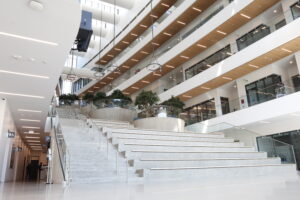By: Rastko Koprivica, Peak Associate
On January 20, the Simon Fraser Student Society (SFSS) notified students that the Student Union Building (SUB) will be closed from January 24 until at least February 18. The decision to close the Student Union Building was made in a Council meeting debate that took three hours. 32 out of 42 councillors voted to close the building for at least three weeks.
In response to the SUB closure, SFU sent out three letters cautioning the SFSS Executive Committee on the potential breach of their lease agreement with the school. The Peak obtained the three letters from an anonymous source and has verified their authenticity with SFU and the SFSS.
The first letter was sent on January 20 from SFU’s vice-president finance and administration Martin Pochurko — the same day as the vote to close the SUB. The letter asked whether the SFU community would still be able to access the SUB’s public spaces. It cited the area of the lease which states the SFSS “agreed to allow reasonable access to the public areas of the SUB (which do not include SFSS offices) by the entire SFU community, during normal operating hours.”
The second letter dated February 1 was sent by SFU’s Office of the General Counsel and University Secretary. It stated the university was receiving feedback from students and their “urgent need of areas in which they can rest and study.” The letter offered “workable options, such as limited staffing models” to facilitate a re-opening. The SFSS’ key factor in closing the SUB was to protect SFSS staff from contracting COVID-19.
The final letter, sent on February 14, stated SFU would be entitled to deliver a written notice of default of the lease to the SFSS if the SUB remained closed. A default means a violation of the rules set out in a contract. Two days later, during a Council meeting, the Council voted unanimously to re-open the SUB at a reduced capacity.
The Peak reached out to SFU for comments.
In a statement, SFU legal counsel Francesca Hennigar wrote, “We know that access to the SUB is very important to our students. As the SUB is part of SFU’s campus, SFU’s expectation is for it to be available as an accessible pathway through campus, as well as a student space, when the university is open. The university reached out multiple times to SFSS to offer support about staffing concerns for the SUB, as well as to remind the SFSS of the lease guidelines for the building that speak to it being a part of the SFU campus and accessible to our community.”
When asked about the SUB’s reduced capacity operation, Hennigar said, “Given that the public health mandated capacity limits have been removed in BC at this time, we hope that the SFSS moves capacity limits in the SUB to be more in line with the rest of campus.”
Currently the university is following its communicable disease plan which aligns with provincial guidelines on public indoor spaces and does not have capacity limits.
Many student groups have protested the return to in-person classes, citing COVID-19 safety and accessibility concerns. Multiple online petitions called for remote options and led to a walkout at the beginning of the Spring semester.
In an interview with The Peak, SFSS acting president Corbett Gildersleve said the letters SFU sent to the SFSS were “primarily to put pressure on Council to vote the way SFU wanted.
“We are confident that legally we are not in breach of our lease,” said Gildersleve. He said the SFSS is still “formulating [a] full response” to SFU’s series of letters.
According to Gildersleve, the re-opening of the SUB was not due to pressure from SFU. “The executives had met the week before and reviewed things like case counts, trends, and data we could find related to COVID-19 situation and from there we recommended to Council to re-open.”
Gildersleve discussed the reasoning for initially closing the SUB. “We chose to do a temporary closure where we have control of when we can ideally close and open,” he said. Gildersleve pointed out if staff are infected, the SUB would be closed due to exposure, and this would lead to more uncertainty in re-opening.
When asked for the rationale behind keeping the SUB at a reduced capacity, Gildersleve said the design of the building was a main factor. “A lot of the SUB is designed for social space. We’re talking about the food court area, where you’re not wearing a mask when you’re eating [ . . . ] that allows for Omicron to transmit,” he said. “The reduced capacity plan [ . . . ] reduces concentration in the building.”
For more information on seating restrictions in the SUB, students can visit the SFSS’ website.














